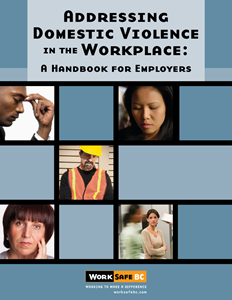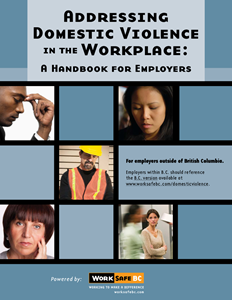Domestic violence in the workplace
The effects of domestic violence may extend outside the home and spill into the workplace. When they do, the safety of a workplace can be compromised. Here you'll find information and resources to help you understand your legal obligations, recognize the signs of domestic violence, and take action to help keep workers and workplaces safe.
- What is domestic violence?
- How does it affect the workplace?
- Reducing the risks
- Resources
More information about each of these steps is available in the handbook and the legal obligations fact sheet (see Resources).
What is domestic violence?
The term "domestic violence" describes a range of behaviours or actions taken by a person to control and dominate another person. It is characterized by abusive, coercive, forceful, or threatening acts or words used by one member of a family, household, or intimate relationship against another.
How does it affect the workplace?
Domestic violence can enter the workplace when an abuser attempts to harass, stalk, threaten, or injure a victim at work. It can affect employee productivity, lead to absenteeism, affect workplace morale, and put a workplace at risk.
Research shows that workplaces can and do make a difference in contributing to the safety and well-being of those experiencing domestic violence.
Being aware of potential signs of domestic violence can help you to take the appropriate measures to prevent it from escalating in your workplace.
Reducing the risks
Workplace violence can arise from a variety of sources, including domestic violence. As an employer, you have a legal obligation to address violence in the workplace that puts your employees at risk. The following four steps can help you meet your legal obligations and reduce the risks for workers.
According to the Occupational Health and Safety Regulation, employers must conduct a risk assessment if there is interaction between employees and persons other than co-workers that might lead to threats or assaults (s4.28). If you learn about domestic violence that puts your employees at risk, you must assess the risk and decide how best to protect your workers.
Conducting a risk assessment for domestic violence in the workplace may be a complex process, depending on the circumstances. An employee may not disclose all the details of her/his situation or may downplay the seriousness of the violence. A situation that appears to be of no immediate threat or danger to workplace safety may change over time. You may wish to seek assistance from a professional to complete a risk assessment for domestic violence in the workplace.
If the threat of violence is imminent, you should contact the police immediately. You must also take steps to eliminate or minimize the risk to workers — for example, secure the premises. When non-imminent threats exist, employers must establish procedures, policies, and a work environment to address the risk (the Regulation, s4.29).
Inform staff of a hazard as soon as it is identified. If you learn of a risk from an individual, you must inform any staff who may encounter the individual in the course of their employment about the person’s identity, the nature and extent of the risk, as well as the necessary controls (the Regulation, s4.30). There is no duty to inform all workers, only those who are likely to encounter the individual in the course of their work. You must balance the requirement to keep workers safe with your employees’ right to confidentiality. This may involve competing legal obligations that must be addressed on a case-by-case basis.
If you learn of a threat, instruct workers on:
- How to recognize the potential for violence
- The policies, procedures, and arrangements in place to address the risk
- How to respond
- How to obtain assistance
- How to report, investigate, and document any incidents of violence (the Regulation, s4.30)
If a violent incident occurs at your workplace, review your obligations under sections 68 to 73 of the Workers Compensation Act and s3.4 of the Regulation to report and/or investigate the incident and take the appropriate action. If a worker is injured in a violent workplace incident, advise the worker to consult with a physician (the Regulation, s4.31).
Resources
In addition to the resources below, please see our resource toolkit for to help you address domestic violence in the workplace.




